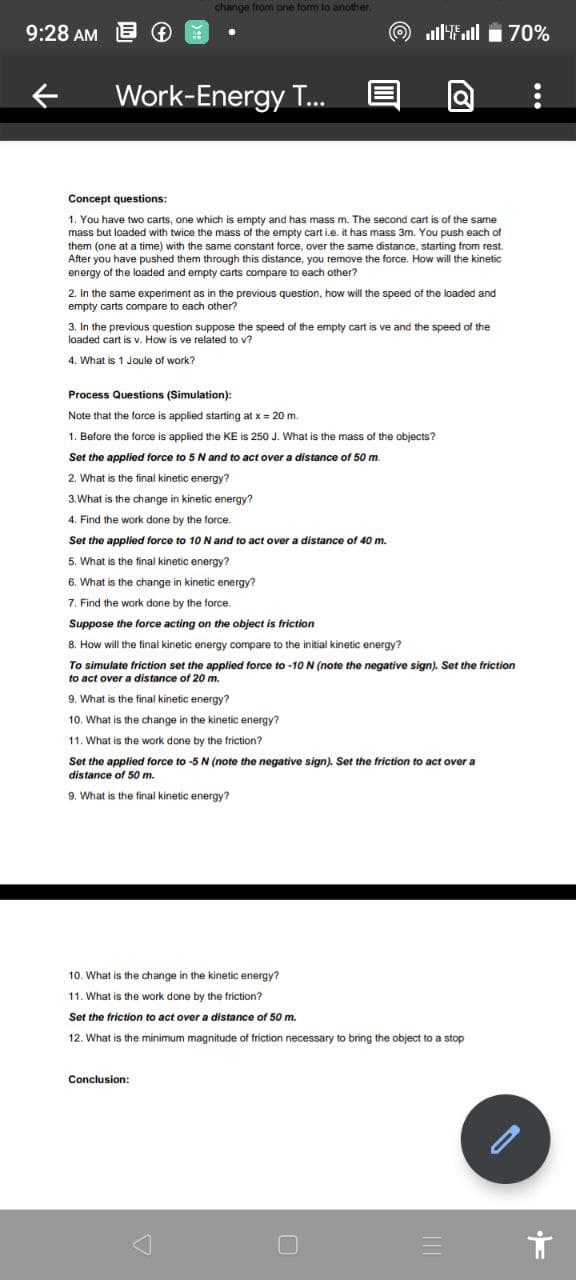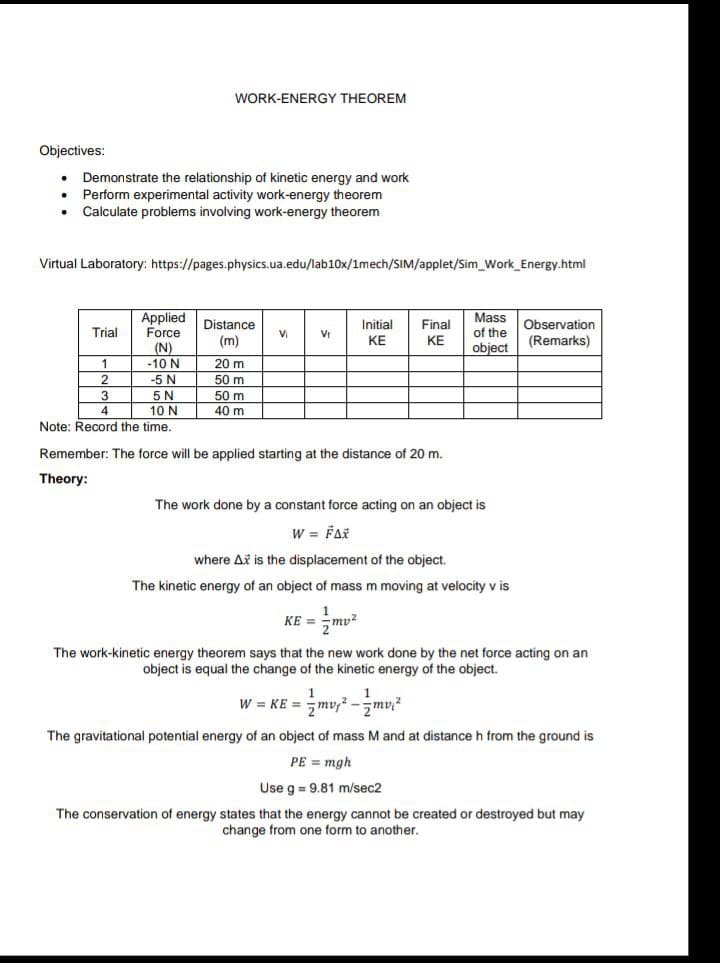1. You have two carts, one which is empty and has mass m. The second cart is of the same mass but loaded with twice the mass of the empty cart i.e. it has mass 3m. You push each of them (one at a time) with the same constant force, over the same distance, starting from rest. After you have pushed them through this distance, you remove the force. How will the kinetic energy of the loaded and empty carts compare to each other? 2. In the same experiment as in the previous question, how will the speed of the loaded and empty carts compare to each other? 3. In the previous question suppose the speed of the empty cart is ve and the speed of the loaded cart is v. How is ve related to v? 4. What is 1 Joule of work?
1. You have two carts, one which is empty and has mass m. The second cart is of the same mass but loaded with twice the mass of the empty cart i.e. it has mass 3m. You push each of them (one at a time) with the same constant force, over the same distance, starting from rest. After you have pushed them through this distance, you remove the force. How will the kinetic energy of the loaded and empty carts compare to each other? 2. In the same experiment as in the previous question, how will the speed of the loaded and empty carts compare to each other? 3. In the previous question suppose the speed of the empty cart is ve and the speed of the loaded cart is v. How is ve related to v? 4. What is 1 Joule of work?
Related questions
Question

Transcribed Image Text:9:28 AM
←
change from one form to another.
Work-Energy T...
....... - 70%
Concept questions:
1. You have two carts, one which is empty and has mass m. The second cart is of the same
mass but loaded with twice the mass of the empty cart i.e. it has mass 3m. You push each of
them (one at a time) with the same constant force, over the same distance, starting from rest.
After you have pushed them through this distance, you remove the force. How will the kinetic
energy of the loaded and empty carts compare to each other?
2. In the same experiment as in the previous question, how will the speed of the loaded and
empty carts compare to each other?
3. In the previous question suppose the speed of the empty cart is ve and the speed of the
loaded cart is v. How is ve related to v?
4. What is 1 Joule of work?
Process Questions (Simulation):
Note that the force is applied starting at x = 20 m.
1. Before the force is applied the KE is 250 J. What is the mass of the objects?
Set the applied force to 5 N and to act over a distance of 50 m.
2. What is the final kinetic energy?
3. What is the change in kinetic energy?
4. Find the work done by the force.
Set the applied force to 10 N and to act over a distance of 40 m.
5. What is the final kinetic energy?
6. What is the change in kinetic energy?
7. Find the work done by the force.
Suppose the force acting on the object is friction
8. How will the final kinetic energy compare to the initial kinetic energy?
To simulate friction set the applied force to -10 N (note the negative sign). Set the friction
to act over a distance of 20 m.
9. What is the final kinetic energy?
10. What is the change in the kinetic energy?
11. What is the work done by the friction?
Set the applied force to -5 N (note the negative sign). Set the friction to act over a
distance of 50 m.
9. What is the final kinetic energy?
Conclusion:
10. What is the change in the kinetic energy?
11. What is the work done by the friction?
Set the friction to act over a distance of 50 m.
12. What is the minimum magnitude of friction necessary to bring the object to a stop
=
Ť

Transcribed Image Text:Objectives:
Demonstrate the relationship of kinetic energy and work
Perform experimental activity work-energy theorem
Calculate problems involving work-energy theorem
Virtual Laboratory: https://pages.physics.ua.edu/lab10x/1mech/SIM/applet/Sim_Work_Energy.html
Trial
WORK-ENERGY THEOREM
1
2
Applied
Force
(N)
-10 N
-5 N
Distance
(m)
20 m
50 m
50 m
40 m
Vi
V₁
Initial
KE
KE =
Final
KE
5 N
10 N
Note: Record the time.
Remember: The force will be applied starting at the distance of 20 m.
Theory:
Mass
of the
object
Observation
(Remarks)
The work done by a constant force acting on an object is
W = FAX
where A is the displacement of the object.
The kinetic energy of an object of mass m moving at velocity v is
mv²
The work-kinetic energy theorem says that the new work done by the net force acting on an
object is equal the change of the kinetic energy of the object.
W = KE = mv₁²-mv²
The gravitational potential energy of an object of mass M and at distance h from the ground is
PE = mgh
Use g = 9.81 m/sec2
The conservation of energy states that the energy cannot be created or destroyed but may
change from one form to another.
Expert Solution
This question has been solved!
Explore an expertly crafted, step-by-step solution for a thorough understanding of key concepts.
This is a popular solution!
Trending now
This is a popular solution!
Step by step
Solved in 2 steps with 2 images
